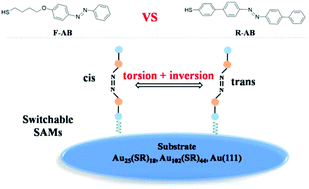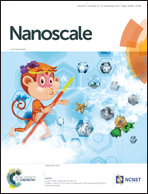Tuning the collective switching behavior of azobenzene/Au hybrid materials: flexible versus rigid azobenzene backbones and Au(111) surfaces versus curved Au nanoparticles†
Abstract
The combination of photo-responsive azobenzene (AB) and biocompatible Au nanomaterials possesses potential applications in diverse fields such as biosensing and thermotherapy. To explore the influence of azobenzene moieties and Au substrates on the collective switching behavior, two different azobenzene derivatives (rigid biphenyl-controlled versus flexible alkoxyl chain-linked) and three different Au substrates (a planar Au(111) surface, curved Au102(SR)44 and Au25(SR)18 clusters) were chosen to form six Au@AB combinations. A reactive molecular dynamics (RMD) model considering both the torsion and inversion path was implemented to simulate the collective photo-induced cis-to-trans switching process of AB monolayers on Au substrates. The major driving force for isomerization is demonstrated to be the torsion of the C–N![[double bond, length as m-dash]](https://www.rsc.org/images/entities/char_e001.gif) N–C dihedral angle, in addition to the minor contribution from an inversion pathway. The isomerization process can be divided into the preliminary conformation switching stage and the later relaxation stage, in which a gradual self-organization is observed for 40 ps. The Au substrate affects the packing structure of the AB monolayer, while the choice of different kinds of ABs tunes the intermolecular interaction in the monolayer. Flexible alkoxyl-linked F-AB may achieve much faster conversion on Au clusters than on the surface. For rigid biphenyl-based R-AB anchored on Au nanoparticles (AuNPs), a competitive torsion between the biphenyl and C–N
N–C dihedral angle, in addition to the minor contribution from an inversion pathway. The isomerization process can be divided into the preliminary conformation switching stage and the later relaxation stage, in which a gradual self-organization is observed for 40 ps. The Au substrate affects the packing structure of the AB monolayer, while the choice of different kinds of ABs tunes the intermolecular interaction in the monolayer. Flexible alkoxyl-linked F-AB may achieve much faster conversion on Au clusters than on the surface. For rigid biphenyl-based R-AB anchored on Au nanoparticles (AuNPs), a competitive torsion between the biphenyl and C–N![[double bond, length as m-dash]](https://www.rsc.org/images/entities/char_e001.gif) N–C dihedral may delay the C–N
N–C dihedral may delay the C–N![[double bond, length as m-dash]](https://www.rsc.org/images/entities/char_e001.gif) N–C dihedral torsion and the following isomerization process. After the R-AB molecules were anchored on the Au(111) surface, the strong π–π stacking between biphenyl units accelerates the collective isomerization process. A curvature-dependent effect is observed for R-AB SAMs on different-sized substrates. The cooperation between functional AB monolayers and the Au substrate determines the collective switching behavior of Au@AB materials. These results are expected to guide rational designs of Au@AB hybrid materials for different uses.
N–C dihedral torsion and the following isomerization process. After the R-AB molecules were anchored on the Au(111) surface, the strong π–π stacking between biphenyl units accelerates the collective isomerization process. A curvature-dependent effect is observed for R-AB SAMs on different-sized substrates. The cooperation between functional AB monolayers and the Au substrate determines the collective switching behavior of Au@AB materials. These results are expected to guide rational designs of Au@AB hybrid materials for different uses.



 Please wait while we load your content...
Please wait while we load your content...